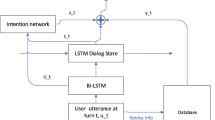Abstract
User simulation is widely used to generate artificial dialogues in order to train statistical spoken dialogue systems and perform evaluations. This paper presents a neural network approach for user modeling that exploits an encoder-decoder bidirectional architecture with a regularization layer for each dialogue act. In order to minimize the impact of data sparsity, the dialogue act space is compressed according to the user goal. Experiments on the Dialogue State Tracking Challenge 2 (DSTC2) dataset provide significant results at dialogue act and slot level predictions, outperforming previous neural user modeling approaches in terms of F1 score.
Access this chapter
Tax calculation will be finalised at checkout
Purchases are for personal use only
Similar content being viewed by others
Notes
References
Asher N, Lascarides A (2001) Indirect speech acts. Synthese 128(1):183–228. https://doi.org/10.1023/A:1010340508140
Chandramohan S, Geist M, Lefevre F, Pietquin O (2011) User simulation in dialogue systems using inverse reinforcement learning. Interspeech 2011:1025–1028
Cho K, van Merriënboer B, Bahdanau D, Bengio Y (2014) On the properties of neural machine translation: encoder–decoder approaches. Syntax Semant Struct Stat Transl, p 103
Core MG, Allen J (1997) Coding dialogs with the damsl annotation scheme. In: AAAI fall symposium on communicative action in humans and machines, Boston, MA, vol 56
Cuayáhuitl H, Renals S, Lemon O, Shimodaira H (2005) Human-computer dialogue simulation using hidden markov models. In: 2005 IEEE workshop on automatic speech recognition and understanding. IEEE, pp 290–295
Eckert W, Levin E, Pieraccini R (1997) User modeling for spoken dialogue system evaluation. In: Proceedings of the IEEE workshop on automatic speech recognition and understanding, 1997. IEEE, pp 80–87
Hancher M (1979) The classification of cooperative illocutionary acts. Lang Soc, pp 1–14
Henderson M, Thomson B, Williams J (2013) Dialog state tracking challenge 2 and 3 handbook. http://camdial.org/mh521/dstc
Hochreiter S, Schmidhuber J (1997) Long short-term memory. Neural Comput 9(8):1735–1780
Hurtado LF, Griol D, Sanchis E, Segarra E (2007) A statistical user simulation technique for the improvement of a spoken dialog system. Springer, Berlin, pp 743–752. https://doi.org/10.1007/978-3-540-76725-1_77
Kingma D, Ba J (2015) Adam: a method for stochastic optimization. In: Proceedings of the 3rd international conference on learning representations (ICLR), pp 1–13
Layla EA, Jing H, Suleman K (2016) A sequence-to-sequence model for user simulation in spoken dialogue systems. In: Interspeech
Levin E, Pieraccini R, Eckert W (2000) A stochastic model of human-machine interaction for learning dialog strategies. IEEE Trans Speech Audio Process 8(1):11–23
Pietquin O (2005) A framework for unsupervised learning of dialogue strategies. Presses univ. de Louvain
Pietquin O, Dutoit T (2006) A probabilistic framework for dialog simulation and optimal strategy learning. IEEE Trans Audio Speech Lang Process 14(2):589–599
Quarteroni S, González M, Riccardi G, Varges S (2010) Combining user intention and error modeling for statistical dialog simulators. In: INTERSPEECH, pp 3022–3025
Rieser V, Lemon O (2006) Cluster-based user simulations for learning dialogue strategies. In: Interspeech
Schatzmann J, Thomson B, Weilhammer K, Ye H, Young S (2007) Agenda-based user simulation for bootstrapping a pomdp dialogue system. In: Human language technologies 2007: the conference of the north american chapter of the association for computational linguistics; companion volume, Short Papers. Association for Computational Linguistics, pp 149–152
Schatzmann J, Weilhammer K, Stuttle M, Young S (2006) A survey of statistical user simulation techniques for reinforcement-learning of dialogue management strategies. Knowl Eng Rev 21(2):97–126
Scheffler K, Young S (2000) Probabilistic simulation of human-machine dialogues. In: Proceedings of the 2000 IEEE international conference on acoustics, speech, and signal processing, 2000, ICASSP’00, vol 2. IEEE, pp II1217–II1220
Acknowledgements
This work has been partially funded by the Spanish Minister of Science under grants TIN2014-54288-C4-4-R and TIN2017-85854-C4-3-R and by the EU H2020 EMPATHIC project grant number 769872.
Author information
Authors and Affiliations
Corresponding author
Editor information
Editors and Affiliations
Rights and permissions
Copyright information
© 2019 Springer International Publishing AG, part of Springer Nature
About this chapter
Cite this chapter
Serras, M., Torres, M.I., del Pozo, A. (2019). Regularized Neural User Model for Goal-Oriented Spoken Dialogue Systems. In: Eskenazi, M., Devillers, L., Mariani, J. (eds) Advanced Social Interaction with Agents . Lecture Notes in Electrical Engineering, vol 510. Springer, Cham. https://doi.org/10.1007/978-3-319-92108-2_24
Download citation
DOI: https://doi.org/10.1007/978-3-319-92108-2_24
Published:
Publisher Name: Springer, Cham
Print ISBN: 978-3-319-92107-5
Online ISBN: 978-3-319-92108-2
eBook Packages: EngineeringEngineering (R0)




